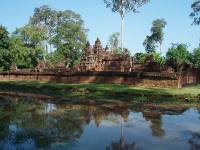Profile
Blog
Photos
Videos
Ankor Wat…..Dollar!Dollar! Dollar!
Ankor Wat is the reason many people come to Siem Reap. It is a vast complex of temples and shrines that date back as far as 10th Century, maybe longer. Today we spent a few hours visiting 4 sites in the complex with Jenny and Linny, Jenny's Australian friend who goes home on Friday.
Apparently, one of the best times to visit the site is at dawn so one can see the sunrise over the temples. Getting up at 0415, however, is the penalty. Heading out into the dark we were driven to the site by Globaltear's faithful TukTuk driver, So Keoung who stayed all day. He is a man of about 45 who has been a driver for about 20 years so he knows all of the roads. For him, this sort of day ensures that he has a good income so that his child(ren) can get a good education. In Cambodia that means a lot since education costs and many cannot afford it. From what we have heard from Jenny the level of corruption here stagers belief. A young man who wants to train to be a teacher, who has been offered all of his fees for 3 years, is unlikely to get on the course because he cannot afford the bribe to the officials. So Cambodia loses and sp does its future.
We arrived at the main site, the one you see as you drive from the airport to the hotels, as the sun rose over the buildings and it was worth the early start. The colours were wonderful and there were few tourists about. Therefore, we were the subject of the Cambodian selling techniques. They rush towards you waving books, postcards, silks, and so on. 'Best prices' or 'You want coffee?' or 'Book cheap, only $10'. This goes on all day wherever one stops and can be just a little annoying. Incidentally, the prices always fall a lot when you say no. All of this is against a background of apparently no planning or organisation; these are just people in the roads, under the trees, often young, even 3 or 4 years old. It's hard to resist at times but essential if one is not to be paying out lots of money for stuff we don't want or can't carry.
After a small coffee at the roadside (so, yes we did buy from them!), we headed into the first of the temples. Many are currently being renovated by foreign states, like Japan as they are in various states of disrepair. Nevertheless, there wonder is clear. Nearly every wall has a vast relief telling some story from the past, usually mythical, but rarely on one piece of stone. The skill of those ancient stonemasons must have been immense. Even without knowing much about the stories they do give clues as to what life was like and the sorts of tools available at the time. Judge for yourselves when you look at some of the photographs that are in the album. PS I have only posted a few!
As we set off across the bridge over the moat leading to the first, perhaps major temple, the heat increasingly became apparent. And it was only 0545. This continued for the rest of the day and we often had to seek relief by heading for a shady spot. The sky was blue so there was limited protection by the clouds. The level of the heat reminded me of France in 2003 when trying to do any work was very hard. Here we just walked slowly.
In some temples, one could climb very steep steps to the highest points and see over the views of the site. This reminded me of our visits to Mexico and Chechen Itza. Although they were taller the similarity lies, in part at least, in the steepness of the steps and the views over the 'jungle'.
I have at least two conflicting views about the temples. Firstly, they tell us something of the past of the Khmer society and perhaps reminds us that Western European society was not the only one that was organised and had, for the time, a high level of skills. Khmer society was clearly advanced for its time.But then again what I really mean is that the Khmer elite society was advanced.
One can admire the wonderful structures and carvings that must have taken an immense effort by that elite. At the same time it also 'cost' a lot: just as with the temples in Bangkok the wealth that was consumed in the construction of these places defies belief. It probably means that those who actually did the work received little pay or compensation. Moreover, it did little to improve their lives.
Perhaps the same is true today. In the midst of depravation and poverty huge international hotels are springing up to cater for the tourists who pay big money for the privilege of adding Ankor Wat to their list of sites they have visited. It is true that the hotels provide work, and the temples provide other work in the form of guides but the training course is 2 years and you must speak at least 2 European languages so how many of them are locals? How much of the money actually gets to the locals who desperately need it? There is also a new golf course, designed by Nick Faldo but for the locals?? I don't think so!
Ok, we are not staying in a large hotel but a local guesthouse, and we are eating in local restaurants. And no, I wo
- comments




